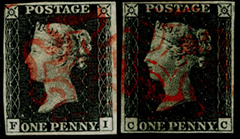 First Issues Collectors Club
of stamps and philatelic material
First Issues Collectors Club
of stamps and philatelic material
Home - Catalog - Categories - Index - Journal - Exhibits - Auctions - Forgeries - Join
 First Issues Collectors Club
of stamps and philatelic material
First Issues Collectors Club
of stamps and philatelic material
Home - Catalog - Categories - Index - Journal - Exhibits - Auctions - Forgeries - Join
| first issues > countries > cape of good hope |
(including British Kaffraria, Mafeking Seiege Stamps, Vryburg)
Imperforate, watermark 15 (anchor), engraved
Designed by Charles Bell (Surveyor-General at the Cape)
Engraved by W. Humphries, Printed by Perkins Bacon
Watermark: Outlined Anchor (arranged in pairs, base to base so that each should appear upright in the stamp)
| Date | Description | # issued (low estimate) | # issued (realistic estimate) | Scott # | Stanley Gibbons # |
|---|---|---|---|---|---|
| September 1, 1853 | 1d red on blued paper | 420,000 | 1,550,000 | 1 | 1,3 |
| September 1, 1853 | 4d blue on blued paper | 465,000 | 2,700,000 | 2 | 2,4 |
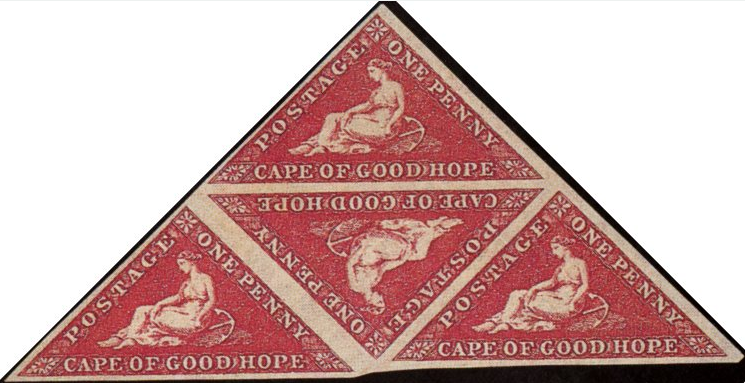 |
block of #1s |
The stamps were printed by Perkins Bacon in London and periodically shipped to the Cape of Good Hope. The date on which each lot of stamps was printed is not known, but dates on which the stamps arrived at the Cape is known and is used as the basis of calculating the number of stamps printed on blued paper. In addition it is understood that some of the 4d blue printings after 1855 (up until 1861) also caused blueing of paper and therefore the number of stamps listed above has to be given as a combination of estimates. Even in the case of the 1d red stamps it is understood that it was not until April 1857 that stamps free from blueing were printed.
Suffice it to say that the customary listing of blued issues from 1853-1855 and the white paper issues from 1855-1861 is not supported by the facts and therefore it is difficult to definitively identify first issue stamps (especially in the case of the 4d blue on blued paper).
The low-end estimate is calculated as the number of stamps that arrived at the Cape between 1853 and 1855 (based on Scott and Stanley Gibbons listings for the blued paper issues). In the case of the 1d red a realistic estimate is calculated as all issues that arrived at the Cape before April 1857. In the case of the 4d blue the realistic estimate is based on a calculation of relative scarcity (derived from catalogue prices of used items).
The cause of the blueing of the paper, which was unintended, is as a result of the introduction of potassium cyanide or ferro cyanide into the inks or paper. The purpose of using this chemical was to make it more difficult for people to clean the cancellation off the stamp. After such a cleaning the resulting print of the stamp would show that the stamp had been tampered with.
The only way to decide if a stamp is on blued paper is to look at the back of the stamp. A stamp is not on blued paper unless the back is definitely blued - whatever the front appears to be.
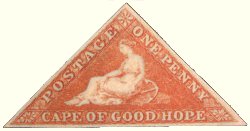 |
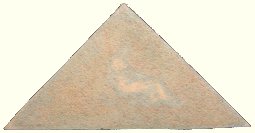 |
A common feature of blued paper is the so-called 'ivory head' appearance at the back of the stamp
All the Cape Triangular plates were prepared from a single Master Die. This Master Die was used to create the Pair Dies for each of the denominations (1d, 4d, 6d and 1s). The Pair Dies in turn where used to manufacture the printing plates that consisted of 15 horizontal rows of 8 pairs each, making 240 stamps.
The 1d red was intended for the prepayment of postage on newspapers and the 4d blue for postage on letters (at a rate of 4d per half-ounce). These first issue denominations were only intended for local correspondence as the postal union had not yet been introduced. It was not until 1857 that an agreement on uniform rates for overseas mail was reached (6d per half-ounce for correspondense between the Cape and the United Kingdom).
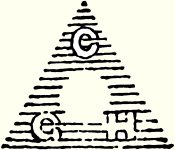 |
The Triangular Defacing Stamp of 1853 (the letters CGH stand for Cape of Good Hope)
The instructions to Postmasters were that each stamp had to be suitably cancelled with the Triangular Defacing Stamp in black ink. Initally there was no date on the letters as the date stamps that were to be used upon despatch and receipt of letters were only introduced from December 1853 onwards (a few months after the stamps were already in use). Therefore the date of September 1st 1853 listed above is the nominal date of first use and as a result there are no 'First Day Covers'.
The Triangular Defacing Stamp is known in colours other than black (red, blue and green), but examples of this are rare and of tremendous philatelic interest.
Thank you very much to Jake Shepherd for all the above information. All errors and omissions are the sole responsibility of the webmaster.
Images from Sandafayre and Robert A. Siegel Auctions.
| FI ref: 47 | Page credit: JA |
| Page created 19 Feb 2014 | Page updated 25 Jan 2016 |